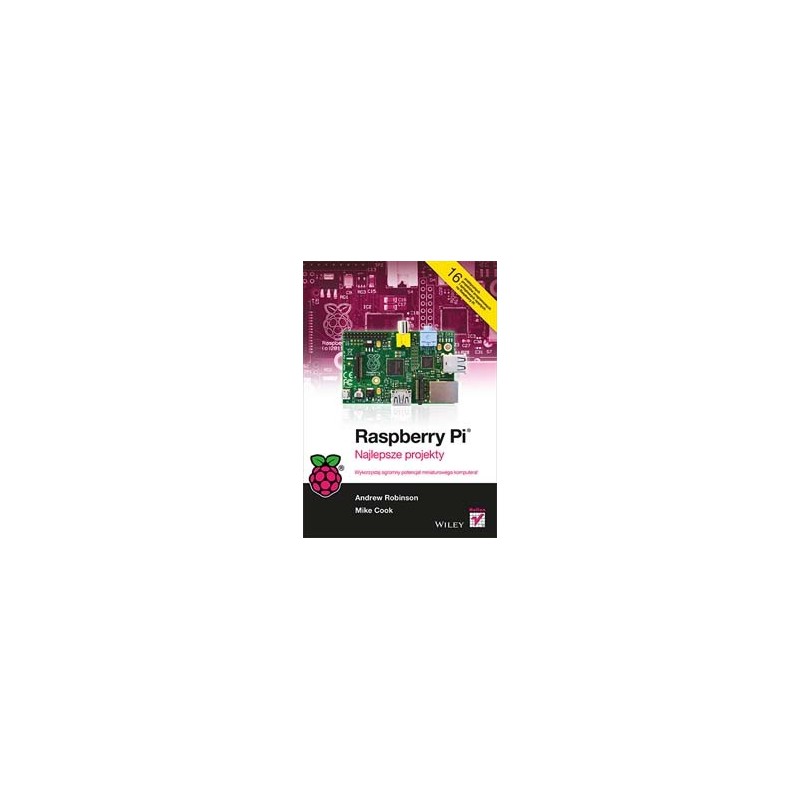- Out-of-Stock

Take advantage of the huge potential of a miniature computer!
Raspberry Pi is a real computer with the size of a slightly overdone credit card. It has huge potential, quite a lot of computing power, and it costs very little. This platform was designed with the idea of learning programming for children. However, as often happens, the story has gone completely different. Currently, Raspberry Pi is used as a web server, movie player or device driver. Do you have a good idea to use Pi in the project? Or maybe you do not know what you would like to do with Raspberry Pi?
This book will dispel all your doubts and suggest ideas for attractive projects. During the reading you will learn about the construction of Raspberry Pi and you will learn how to connect it and run the Linux system. In the following chapters you will prepare a game of a cross and a cross and create your own teleprompter. If you need an electronic clock to measure your reaction time or dream about a twittdling toy, then you are holding the right book! If you want to live in a smart home for reasonable money - you will be interested in the chapter devoted to its automation. Check how easy it is! It is a must-read for all enthusiasts who want to squeeze the seventh sweat out of Raspberry Pi!
Reach for this book and:
A collection of the best projects for Pi!
Table of Contents
Introduction (13)
PART I: INTRODUCTION TO PI RASPBERRY (21)
Chapter 1. Starting Raspberry Pi (23)
Chapter 2. Introductory software project - insults generator (43)
PART II: PROJECTS OF THE SOFTWARE (59)
Chapter 3. Tic-tac-toe (61)
Chapter 4. Here is an overview of the latest news (81)
Chapter 5. Ping (101)
Chapter 6. Pie Man (125)
Chapter 7. Generating labyrinths in Minecraft (151)
PART III: HARDWARE PROJECTS (173)
Chapter 8. The colorful version of Snap (175)
Chapter 9. Check your response time (197)
Chapter 10. Twittująca toy (219)
Chapter 11. Disco lights (241)
Chapter 12. Door lock (263)
Chapter 13. Home automation (283)
Chapter 14. Computer control of track electronics with cars (313)
Chapter 15. Generating graphics and posting them on Facebook (333)
Chapter 16. Harmonograph (357)
Chapter 17. Advanced birdhouse - observing nature (391)
Index (425)
Raspberry Pi 3 model B (Quad Core Broadcom BCM2837, 4x1.2GHz ARM Cortex-A53, RAM 1GB, 4xUSB, Ethernet, HDMI, Wifi, Bluetooth)
No product available!
The Raspberry Pi 3 Model B+ is boasting a 64-bit quad core processor BCM2837B0 running at 1.4GHz, dual-band 2.4GHz and 5GHz wireless LAN, Bluetooth 4.2/BLE, faster Ethernet, and PoE capability via a separate PoE HAT
No product available!
No product available!
No product available!
ADMP401 MEMS Microphone Breakout Board
No product available!
BleBox AirSensor is an air quality sensor informing about the presence of harmful dust (PM1, PM2,5, PM10) suspended in the home and outside.
No product available!
No product available!
C-Mount lens. Focal length 5 mm, FoV 60.3° (H), 47.1° (V) manual focus and adjustable aperture. Designed to work with the Raspberry Pi HQ camera. ArduCAM LN042
No product available!
No product available!
No product available!
No product available!
ROSA3D filament made of high-quality water-soluble PVA. 0.5 kg of filament with a diameter of 1.75 mm is wound on the spool. ROSA3D PVA Natural
No product available!
No product available!
ROSA3D filament made of high-quality PET-G granules. 0.5 kg of filament with a diameter of 1.75 mm is wound on the spool. ROSA3D PET-G Standard Glow in the Dark Green
No product available!
T-Cobbler Plus - adapter enabling connection of GPIO Raspberry Pi A +, B + and Pi 2 lines to the contact plate (2.54 mm). Goldpin connectors are included, for self-assembly. Adafruit 1989
No product available!
No product available!
No product available!

Andrew Robinson, Mike Cook
